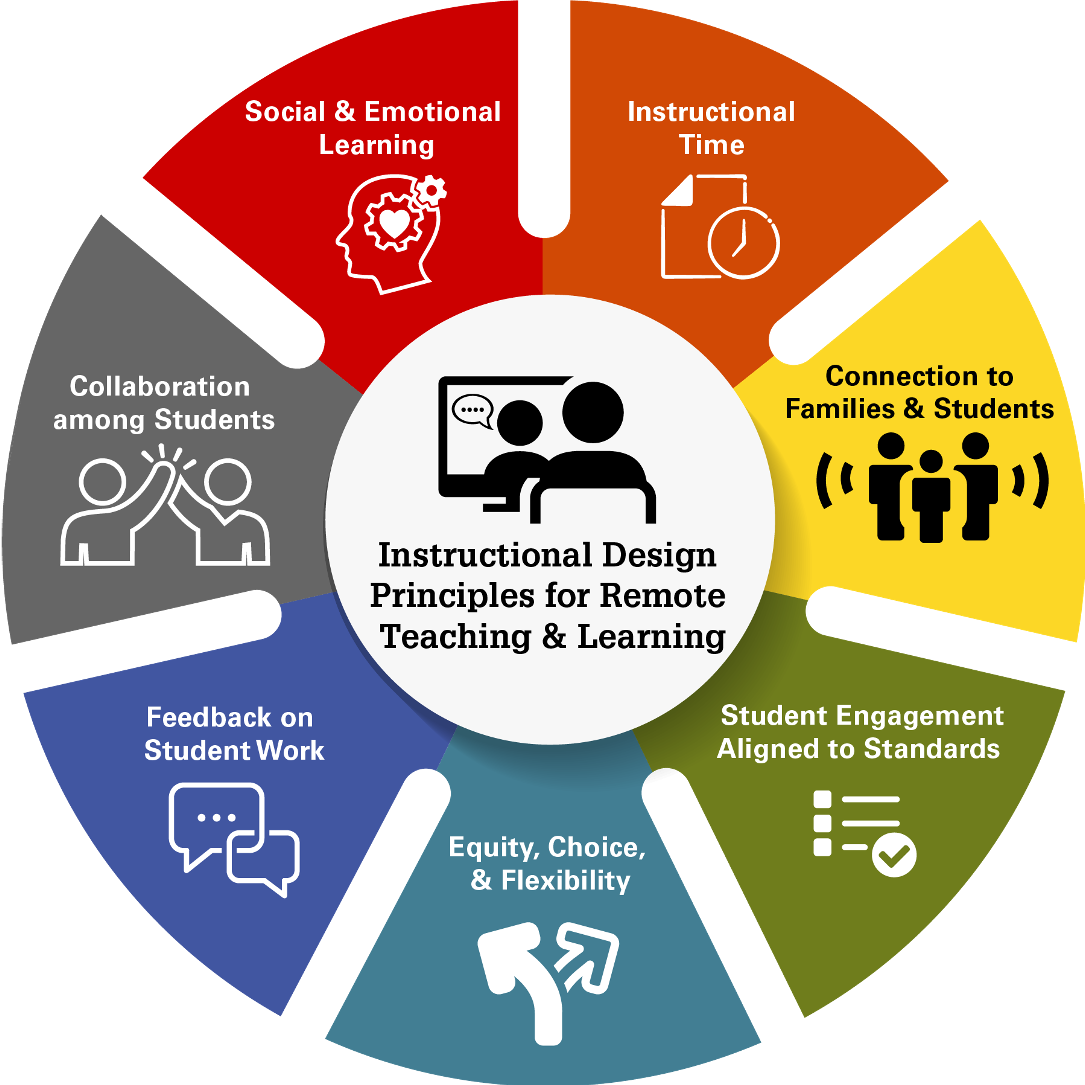Instructional Design Principles for Remote Teaching and Learning
In alignment with NCDPI and the NC State Board of Education’s mission and vision, the Instructional Principles for Remote Teaching & Learning are designed to provide guidance for student learning across North Carolina when state, national, or international crises impede students from learning in their regular school setting.

These seven instructional design principles are overarching and intended to apply to a range of learning environments and contexts with the acknowledgment that students and teachers have different levels of access to devices and the Internet.
Instructional Design Principles
Instructional Time Expectations
The amount of time students are expected to learn and complete academic work in a remote setting should differ from instruction delivered in a physical classroom. You should not assume students will be spending the traditional hours or the same amount of time on learning as when they are in the classroom.
Connection and Communication with Families and Students
Schools are often the hub of our communities and play a significant role in their students’ and families’ lives, including and beyond academics. In transitioning to remote learning, having regular and predictable opportunities for families and students to connect with their teachers and schools is key.
Student Engagement in Learning Opportunities Aligned to Standards
Designing learning opportunities aligned to standards that engage students is critical to support students’ academic and social and emotional growth. Educators will have to adapt these learning experiences to a remote setting with and/or without access to devices and the Internet. Educators should provide a recommended schedule with flexible options and assume that students will have minimal supervision or guidance.
Equity, Choice, and Flexibility
As educators design learning opportunities for students in a remote learning environment, it is important for educators to design instruction with choice and flexibility, especially when considering student populations that typically have additional support while in school. Instruction should include enough flexibility and choice to reduce instances of students feeling overwhelmed, disinterested, and/or frustrated.
Collaboration Among Students
Students need social interaction, and collaborating with one another is an effective strategy for learning that also supports the whole child. The key is trying to ensure that students are collaborating and connecting with each other multiple times each week through thoughtful, yet simple lessons.
Feedback on Student Work
Feedback has the potential to have a powerful impact on student learning and motivation, and educators will need means to assess (even if not through graded tests) how students are progressing in their learning. Regular and timely feedback will play an important role in guiding students in their instruction.
Social and Emotional Learning (Cross-cutting, Embedded, or both)
Addressing social and emotional learning (SEL) effectively is proven to support the whole child and increase achievement, and this is never more important than during a crisis. As schools, districts, and teachers work to provide continuity of learning for their students, SEL should be at the forefront of structures and learning opportunities.
Applying the Instructional Design Principles
As schools and teachers design learning opportunities, the Instructional Design Principles are intended to serve as guideposts for developing lessons and connecting communities. It is important to remember that instruction during remote learning will look different than it does in the face-to-face classroom. The current cause of remote learning and the fact that students and families cannot come together in a physical space make the sense of community and belonging only more important.
As the weeks progress, educators and students need to be open and flexible as we figure out remote learning together. The Instructional Design Principles illustrate the importance of focusing on the whole child and connecting with students and families to ensure that schools continue to play their essential and central role in the community.
For More Opportunities Aligned to These Principles
The Friday Institute is partnering with the North Carolina Department of Public Instruction to provide professional learning opportunities for educators to support their implementation of remote learning during the COVID-19 crisis. Sessions will be run multiple times and will change week by week.
Learn more about Remote Learning to Support NC Educators.
Downloads
 One-Page Summary; One-Page Summary-Espanol
One-Page Summary; One-Page Summary-Espanol
Related Resources
White Paper – Engaging Your Latino Families During This Time of Crisis
Methods, suggestions and ideas to better reach and engage your Latin families during the COVID-19 crisis
White Paper – Recommendations for Instructional Leaders
The Instructional Principles for Remote Teaching & Learning provide guidance for remote learning across NC during COVID-19.
Teams
 Professional Learning and Leading Collaborative
Professional Learning and Leading Collaborative
Projects
In its commitment to support educators and provide resources for teaching and learning, the Friday Institute has created resources for educators during this time of uncertainty.
Remote Learning to Support NC Educators
The Friday Institute is partnering with the North Carolina Department of Public Instruction to provide professional learning opportunities for educators to support their implementation of remote learning during the COVID-19 crisis. Sessions will be run multiple times and will change week by week.
Teaching Remotely: A Practical Guide
Teaching Remotely: A Practical Guide will provide educators with best practices, resources and strategies to set their remote learning classroom up for success.
Published
April 7, 2020
Resource Type
White Paper
Published By
Friday Institute for Educational Innovation
 Complete Report
Complete Report  Graphic (PNG)
Graphic (PNG)